Being a part of the Canadian production of Chandralekha’s “Sri” in 2009, I am reminded of the word which is at the core of my dance practice. That word is process. When I dance, my body opens up, becoming a doorway through which each new movement enters into my being and transforms it. Since beginning work on “Sri”, the concept of empowerment, the central theme of the piece, has entered into my body and had ramifications throughout every aspect of my life. As I acquaint myself with Chandralekha’s philosophy of art-making, I see that it is visceral and process-oriented. Working from a premise of non-duality between audience and performer, she has proven that process-oriented art can be engaging for both parties. Dancing in this piece has also given me new insight into the multifaceted experiences of being a woman in India and in the U.S. and the ways in which women are enslaved or empowered in both cultures. I have begun to think about what empowerment means to me and what my archetypes of power are.
“Art” can be defined in many ways. The particular definition of “art” which I relate to in terms of my dance practice is what Webster’s dictionary calls “skill; craftsmanship”. Any skill or craft takes hours to perfect. Through these long hours of practice, the artist is automatically transformed. The transformation is slow and may not be immediately obvious, but inevitably has long-lasting effects on the individual’s body, habits, behavior and emotions. I would even go so far as to equate the process of accumulation of artistic skill with the Sanskrit word “sadhana”, defined in one of many ways as “diligent practice”. This regular practice of purification has deep karmic effects on the psyche and the soul.
According to Vedantic philosophy, the individual body is made up of five sheaths, or “koshas”, which, beginning with the physical body or “annamaya kosha”, get progressively more and more subtle until one reaches the “atman” or true self, which is neither born nor dies. Each of these “bodies” is intimately connected. When something occurs in the physical body it has an effect on the more subtle bodies, hence by transforming our breath, spine, muscles, tendons, eyes or other body parts, we can transform our emotions and psyches. When the body is in a position of release, falling, or “bent-overness”, the emotions of hopelessness, lifelessness, depression, resignation and powerlessness are triggered. With the straightening of the back and the lengthening of the spine and the tendons of the body from toe to crown there is a feeling of strength, purpose, fullness and power. With the forward projection of the chin, chest and energy from the eyes there is a sense of moving forward into the future, a feeling of hopefulness, a strong presence and a charge of energy.
In the first half of Chandralekha’s “Sri” choreography, the individual dancers’ bodies are thrust forward and backward with spines bent, collapsed, tilted and rotated. Individuals are isolated and moving haphazardly and without eye contact. In the second half of the piece, the dancers’ spines are straight and our feet stamp with strength and purpose. Our eyes are full of focus and intention. Our bodies are taut with readiness and our core muscles are strong and engaged. As a group, the dancers’ bodies move toward solidarity and synchronicity. As we move from bent to straightened bodies, we move emotionally from hopelessness to vision, from powerlessness to empowerment. As we move from isolation to solidarity, our individual power is multiplied as we are supported and strengthened in the group.
Movements from the martial art form Kaleripayatu and techniques of Yoga are blended into the choreography. This feels like another means of giving the artists a doorway into experiencing the transformation in the piece as these are not performing art forms themselves but are tools for the personal growth process.
When I practice and perform “Sri” I am personally taken on a visceral journey of empowerment. After my work in the studio, my body remembers the experience and it carries over into my entire life. Since beginning work on “Sri”, my way of walking, standing, speaking, seeing and behaving in the world has begun to change. People are reacting to me differently. I am reacting differently to situations. As I begin to take risks, new possibilities are emerging and old patterns are starting to shift. This process alone is enough reason to make me believe that mounting a production of “Sri” in 2008-2009 is absolutely relevant for me and would in fact be relevant for any dancer at any time. Because I firmly believe that everything in life happens for a reason and because I choose to move towards growth and wholeness, I look for the lesson in each of my experiences. It is time for me to bring empowerment into my life and performing in this production of “Sri” is my opportunity to do so.
I recently saw an interview with Chandralekha in which she discusses her search for meaning in dance. She says, “I ask questions and I follow those questions. For me, answers have no meaning. I’m not seeking answers. I just follow wherever they take me and I think that journey itself is a very important journey.” Hearing her speak about the importance which she attaches to process affirmed what I had been feeling while working on “Sri” and strengthened my belief that if a piece of art is long-lasting and universally relevant, one doesn’t need to hear the artist talk about his or her work to feel its power, to relate to it strongly and personally and to understand it. The work itself is the medium of communication. One of the questions which Chandralekha asks herself is, “Would I want dance as entertainment or would I want to see the values of life in it?” Chandralekha’s dance is a dance of ideas, yet her treatment of ideas is non-narrative. In the interview it is mentioned that in her deconstruction of the narrative format of Bharat Natyam, Chandralekha has moved away from mythological themes in her productions. She could be called a follower of Advaita Vedanta or “non-dualism” for expressing the ideas of mythology in a non-deistic format and for doing away with the historical duality of “devadasi” and deity. As artists performing her work we are not entertaining, praising, glorifying or worshipping the Gods with our dance but are instead engaging in a process of awakening the divine power within. We ourselves are invoking/igniting/kindling/opening/breathing into/knocking on the door of our internal divinity or source of unlimited power and energy. When we become empowered we don’t rely on our connection to an external benevolent “God” force which we may or may not have access to. We as artists are also not placing ourselves as a priest-like medium between the audience and the divine whereby the audience members connect with the mythological figures which we are portraying via our own intense connection with those divine figures.
The "rasa" theory proposed by Bharat Muni in the Natya Shastra and elaborated on by many theorists of Indian aesthetics up to the modern age presupposes a duality between performer and audience. Just as Chandralekha’s form of empowered, process-oriented choreography breaks down the duality between the devotee and the divine, it also breaks down the duality between the performer and the audience. As artists, we are not communicating to the audience a “rasa” which we have channeled from without, but are opening the doorway to the path which leads in. By connecting to the available power in our own bodies in the here and now, we are thereby empowering the audience members to connect with their own internal sources of power. To quote Chandralekha, “The feelings that you get from dance, is it transferable? Can you make those feelings in the spectators, the viewers? It is possible to transfer those energies if you can connect them with it, bring them closer to their own bodies, their own breathe, their own energies and how to renew those energies yourself. That is the real meaning that you can generate energy in your own body. You are conscious of your own blood, breathe-your whole body is so vibrant. Dance for self-renewal rather than for frontal projections. Audience members have said, today I became conscious of my own breathe. Today I became conscious of my own body. To me, this is reaching out.”
We may ask ourselves how much we can focus on the process of art-making without losing sight of the fact that the final product must create a worthwhile viewing experience for the audience and have validity as a piece of art rather than simply as a peep-show into the artist’s personal journey. I feel that “Sri” has power and validity as a piece of work beyond its transformative power for the dancers because the individual dancers are performing within the wider framework of a master plan or piece of choreography which is an orchestration of theme, costumes, light, color, music, form and movement. All of these elements can be assessed according to culturally accepted rubrics for determining whether or not it is “good” art. Ultimately, whether or not an individual audience member thinks that the piece and the production are “good” is a matter of personal taste. One can say, however, that if the performer has completed the process of becoming the dance and while dancing if she/he lives that process, then the audience also lives it. The analogy of the final production is like that of a tree which has grown from a seed into full towering majesty. In the full-grown tree we can also see the seed and the process of growth. If the dancer has digested and is present through each nuance of the transformation from enslavement to empowerment and if the choreography is strong, then the audience member too goes emotionally with the performer through that transformation and it will definitely linger in his/her mind and he/she will take that home where it becomes an element of his/her own life-process.
In India I often compared my own experiences as a woman to those of my friends, teachers and colleagues. I realized that what I value most about my own life is my freedom and independence. Conversely, I feel that in the west where there is a great degree of freedom and independence from societal or family pressures and expectations, one of the things sorely missing is a sense of community. Indian society and the Indian family structure can be both oppressive and supportive. A person working within that structure could feel either stifled or secure. One important element for me about Chandralekha’s vision of empowerment in “Sri” is that strength is found in numbers and that empowerment does not happen individually, but as a group. This vision is uniquely suited to the Indian social structure and provides a beautiful and fitting utopian vision for an empowered future society in which women’s innate divine strength is fully realized. The vision for empowerment in “Sri” is a harmonious blend of the best from east and west-freedom from bondage and strength in community. In the same way, the choreographic elements in “Sri” are a harmonious blend of traditional modalities and contemporary sensibility.
Chandralekha’s vision in “Sri” resonates with my mission as an artist. The piece calls out for the universal community of women to come together. I believe that as women, we should learn about each other, perform each other’s dances, see each other’s work and reach out to one another. What happens to one happens to all. We are not separate. We may have many different life experiences and different core beliefs, but humanity is one and womanhood is one. We are all manifestations of the archetypal feminine energy which inspires us to love, nurture and protect. We should help women who are being abused and oppressed everywhere-far and near. We can use our art to inspire, to awaken, to empower, to give voice, to share stories, to share imagery, to be together in community and to learn from one another.
At the conclusion of “Sri”, we become the goddess, showing that as a community we are Her collective power. Each of our arms is one of her ten or ten thousand arms. Each of our arms is doing her work on earth and each one of our heads is wearing one of her human masks. We are the faces of Kamala, Sri, Lakshmi, Durga….One thousand and eight names and countless faces, arms and eyes. Woman is the Goddess.





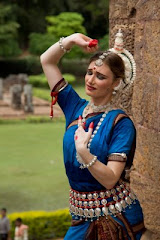



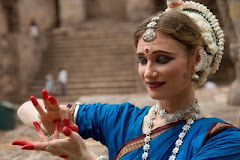

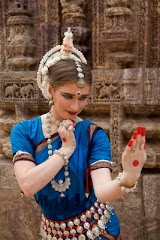

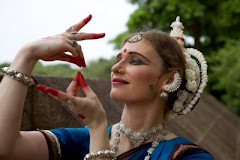
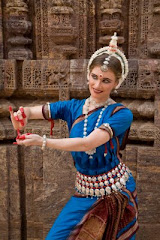





1 comment:
Thank you Amanda for this beautiful and powerful writing on your experiences while dancing this work by Chandralekha. What a gift it must have been and your writing about it is a gift for me now.
Post a Comment